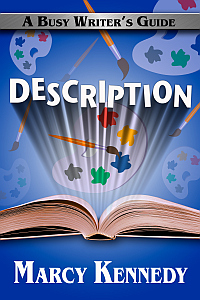We’ve probably all heard (or thought!) that description is boring. The part readers skip.
There’s no question that description has a bad reputation. Yet if we’ve ever read a story without enough description and been lost at what was happening or who was doing what, we know that description is essential to clearly showing events in our story to readers.
When I first started writing, I struggled with description, mostly by including way too much of it. Pages and pages. *smile*
I eventually learned how to balance description and use it to anchor readers in a character’s point of view. However, there’s another way to make description work harder for our story, and that’s by using contrast to create more powerful and interesting descriptions.
Luckily for us, editor-author Marcy Kennedy is here with us today to give us the scoop and share five methods to empower our description with contrast. Please welcome Marcy Kennedy! *smile*
*****
The Power of Contrast in Description
Readers need description to help them imagine the story world and to keep them grounded in the story, but often it’s considered the slow, boring part.
It doesn’t have to be.
Done right, description keeps the pace moving and brings out our point-of-view character’s emotions, backstory, and conflicts. It can also add subtext, foreshadow, and build on the theme.
One of my favorite ways to bring description to life and make sure it serves a bigger purpose in the story is to use contrast. I’m excited Jami welcomed me back to share with all of you how to make this work.
All of these tips work best—in my opinion—when we write in a limited point of view because it’s our point-of-view character who’s making the comparison. The description filters through them and is colored by who they are. (Though I’m sure you omniscient writers could adapt many of these techniques as well.)
Tip #1: Contrast What the POV Character Expected with What They Experience
Look at this example from Lindsay Buroker’s steampunk romance novel Deathmaker. The POV character is about to meet the man who designed the biological weapon that wiped out an entire city of her people.
The man standing in the doorway, his hands shackled before him, appeared more warrior than scientist, with a hide vest leaving his muscular arms and part of his chest exposed. She had expected a crazy old man with spectacles or magnifying goggles and white hair sticking out in all directions. The figure in the doorway appeared to be about thirty, and his long black locks fell down his back in matted ropes.
A contrast like this shows us a bit about the point-of-view character because we see their expectations about how a certain type of person or a certain type of location “should” look.
It also adds tension and intrigue. Why doesn’t this character or location fit the expectation? Is the appearance meant to be deceiving? Is there a conflict happening inside the character between who they’re supposed to be and who they want to be? The point-of-view character doesn’t know and neither do we, which makes us want to read on to find out the truth.
Tip #2: Contrast What Everyone Else Experiences With the Truth Known by Our POV Character
This one plays with the idea of perception vs. reality again, but in the opposite way that the first point did. This time, our point-of-view character knows the true nature of the person or place they’re describing and everyone else is deceived by the external experience.
Let me show you what I mean using a description from Orson Scott Card’s Ender’s Game.
Ender did not see Peter as the beautiful ten-year-old boy that grown-ups saw, with dark, tousled hair and a face that could have belonged to Alexander the Great. Ender looked at Peter only to detect anger or boredom, the dangerous moods that almost always led to pain.
Tip #3: Show How a Change Affects Their Normal Experience of a Person or Place
A change in our character’s normal world, or a change in a person they know well, often foreshadows or adds conflict. Suzanne Collins does this in The Hunger Games. The description of the square on reaping day isn’t just a static recitation of details. She juxtaposes how it normally looks and feels with how it changes on this single day.
Take a look.
It’s too bad really, that they hold the reaping in the square—one of the few places in District 12 that can be pleasant. The square’s surrounded by shops, and on public market days, especially if there’s good weather, it has a holiday feel to it. But today, despite the bright banners hanging on the buildings, there’s an air of grimness. The camera crews, perched like buzzards on rooftops, only add to the effect.
This type of contrast is great for describing something our point-of-view character would normally ignore because they’ve seen it so often. It’s also a good tool for setting the mood of a scene because our point-of-view character’s emotions about the change color the description.
Tip #4: Contrast the Past with the Present
This could be contrasting what a character once had with what they have now, or it could be comparing the way a person or place has changed over time.
Our first introduction to King Robert Baratheon in Chapter One of Game of Thrones comes through Ned Stark’s eyes—eyes that remember the king in his prime, strong, lean, and smelling of blood and leather. The Robert who comes to Winterfell after so many years is fat and smells of perfume instead.
Had George R. R. Martin only described King Robert as he presently was, we’d have had no idea of how far he’d fallen. It’s the contrast, the opposites, that make the description so powerful and memorable.
Contrasting what was with what is in description has the added benefit of allowing us to weave in backstory in a believable way rather than infodumping it. (If you read the description of King Robert, you’ll also see how backstory is woven seamlessly in.)
Bonus Tip: Contrast a Good Smell with a Bad One
Choosing two antagonistic scents can be done to make both smells stand out more than they would on their own, to complement a theme, or to subtly support what’s happening inside your character.
In The Hunger Games trilogy, President Snow smells like blood and roses. He uses the roses to cover up the fact that his breath reeks of blood, and this becomes a metaphor in a way for how the beauty and glitz of the capital tries to disguise the repulsiveness of the country’s situation. Suzanne Collins could have just had him smell like blood, but the contrast with something as beautiful and symbolic as roses made the smell of blood that much more grotesque. And Katniss is never able to think about roses the same way again.
*****
 Marcy Kennedy is a science fiction and fantasy author who believes there’s always hope. Sometimes you just have to dig a little harder to find it.
Marcy Kennedy is a science fiction and fantasy author who believes there’s always hope. Sometimes you just have to dig a little harder to find it.
She’s also the author of the bestselling Busy Writer’s Guide series, which focuses on giving authors deep teaching while still respecting their time.
You can find her blogging about writing and about the place where real life meets science fiction, fantasy, and myth on her website.
*****
 About Description: A Busy Writer’s Guide:
About Description: A Busy Writer’s Guide:
Description in fiction shouldn’t be boring for the reader or for the writer.
Description: A Busy Writer’s Guide will help you take your writing to the next level by exchanging ho-hum description for description that’s compelling and will bring your story to life, regardless of the genre you write.
In Description: A Busy Writer’s Guide, you will
- find the answer to the age-old question of how much description is too much;
- learn how to use point of view to keep description fresh;
- recognize the red flags for boring description in fiction;
- explore how to use all five senses to bring your descriptions to life for the reader;
- discover the ways metaphors and similes can add power to your descriptive writing;
- gain the tools needed to describe setting, characters, and action in engaging ways;
- learn how descriptions can add conflict, enhance the theme, and amp up emotion; and
- much more.
*****
Thank you, Marcy! As a former inflicter-of-poor-description, I love these tips—and great examples to illustrate your ideas too!
I especially love how Tip #4 demonstrates how our description can work harder. While we might usually weave description in with more active elements of our writing, we can also weave other elements—like the backstory example here—into description.
Powerful writing pulls double or triple duty, and that applies to description as well. By using contrast with our descriptions, we can add emotions, motivations, character development, backstory, etc. to a sentence or paragraph that might otherwise be bland and flat.
All those extra elements will keep our description from being boring. No one will skip description when it feels like part of the story. *smile*
Do you notice description less if it feels like a powerful aspect of the story? Do you like using contrast in your writing style? Have you tried it with descriptions before? Do you have any questions for Marcy? Can you think of other examples of how contrast or comparison would help bring description to life? Or feel free to share an example of when you’ve done this in your current WIP!

